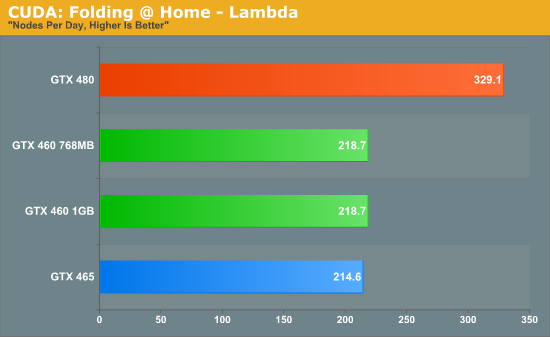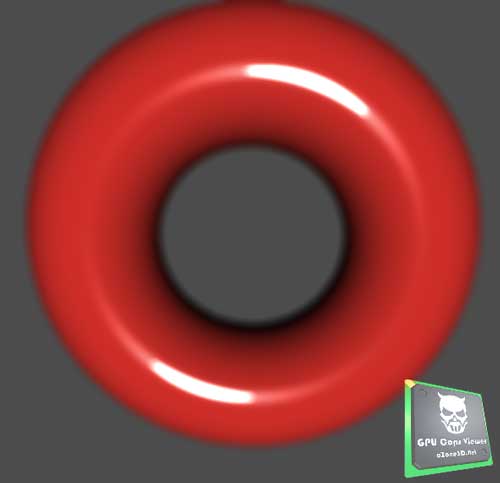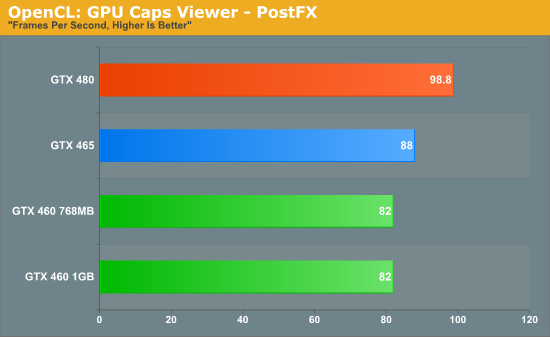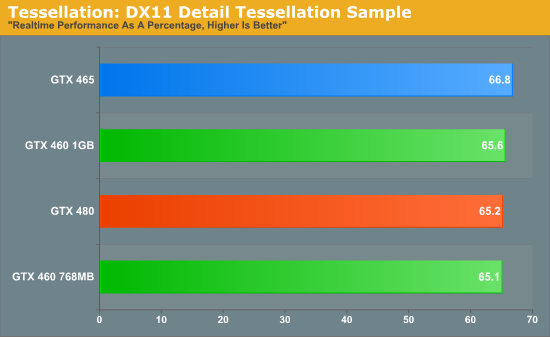NVIDIA’s GeForce GTX 460: The $200 King
by Ryan Smith on July 11, 2010 11:54 PM EST- Posted in
- GPUs
- GeForce GTX 400
- GeForce GTX 460
- NVIDIA
Compute & Tessellation Performance
With our earlier discussion on the GF104’s revised architecture in mind, along with our gaming benchmarks we have also run a selection of compute and tessellation benchmarks specifically to look at the architecture. Due to the fact that NVIDIA added an additional block of CUDA cores to an SM without adding another warp scheduler, the resulting superscalar design requires that the card extract ILP from the warps in order to simultaneously utilize all 3 blocks of CUDA cores.
As a result the range of best case to worst case scenarios is wider on GF104 than it is GF100: while GF100 could virtually always keep 2 warps going and reach peak utilization, GF104 can only reach peak utilization when at least 1 of the warps has an ILP-safe instruction waiting to go, otherwise the 3rd block of CUDA cores is effectively stalled and a GTX 460 performs more like a 224 CUDA core part. Conversely with a total of 4 dispatch units GF104 is capable of exceeding GF100’s efficiency by utilizing 4 of 7 execution blocks in an SM instead of 2 of 6.
Or in other words, GF104 has the possibility of being more or less efficient than GF100.
For our testing we’re utilizing a GTX 480, a GTX 465, and both versions of the GTX 460, the latter in particular to see if the lack of L2 cache or memory bandwidth will have a significant impact on compute performance. Something to keep in mind is that with its higher clockspeed, the GTX 460 has more compute performance on paper than the GTX 465 – 907GFLOPs for the GTX 460, versus 855GFLOPs for the GTX 465. As such the GTX 460 has the potential to win, but only when it can extract enough ILP to keep the 3rd block of CUDA cores working. Otherwise the worst case scenario – every math instruction is dependent – is 605GFLOPs for the GTX 460. Meanwhile the GTX 480 is capable of 1344GFLOPs, which means the GTX 465 and GTX 460 are 63% and 45%-67% as fast as it on paper respectively.

We’ll start with Stanford’s Folding@Home client. Here we’re using the same benchmark version of the client as from our GTX 480 article, running the Lambda work-unit. In this case we almost have a tie between the GTX 460 and the GTX 465, with the two differing by only a few nodes per day. The GTX 465 reaches 65% of the performance of the GTX 480 here, which is actually beyond the theoretical performance difference. In this case it’s likely that the GTX 480 may be held back elsewhere, allowing slower cards to shorten the gap by some degree.
With that in mind the GTX 460 cards achieve 66% of the performance of the GTX 480 here, giving them a slight edge over the GTX 465. Because we’ve seen the GTX 465 pull off better than perfect scaling here it’s very unlikely that the GTX 460 is actually achieving a perfect ILP scenario here, but clearly it must be close. Folding@Home is clearly not L2 cache or memory bandwidth dependent either, as the 768MB version of the GTX 460 does no worse than its 1GB counterpart.

Next up on our list of compute benchmarks is Badaboom, the CUDA-based video encoder. Here we’re measuring the average framerate for the encode of a 2 minute 1080i video cap. Right off the bat we’re seeing dramatically different results than we saw with Folding@Home, with the GTX 460 cards falling well behind the GTX 465. It’s immediately clear here that Badaboom is presenting a sub-optimal scenario for the GTX 460 where the GPU cannot effectively extract much ILP from the program’s warps. At 56% the speed of a GTX 480, this is worse off than what we saw with Folding@Home but is also right in the middle of our best/worst case scenarios – if anything Badaboom is probably very close to average.
Meanwhile this is another program with the lack of memory bandwidth and L2 cache is not affecting the 768MB card in the slightest, as it returns the same 35fps rate as the 1GB card.


Our third and final compute benchmark is the PostFX OpenCL benchmark from GPU Caps Viewer. The PostFX benchmark clearly isn’t solely compute limited on the GTX 400 series, giving us a fairly narrow range of results that are otherwise consistent with the Badaboom. At 82fps, this puts the GTX 460 below the GTX 465 by around 7%, once again showcasing that the superscalar GTX 460 has more trouble achieving its peak efficiency than the more straightforward GTX 465.


Our final benchmark is a quick look at tessellation. As GF104 packed more CUDA cores in to a SM, the GPU has more than half the compute capabilities of GF100 but only a straight 50% the geometry capabilities. Specifically, the GTX 460 has 45% of the geometry capabilities of the GTX 480 after taking in to account the number of active SMs and the clockspeed difference.
With the DirectX 11 Detail Tessellation sample program, we’re primarily looking at whether we can throw a high enough tessellation load at the GPU to overwhelm its tessellation abilities and bring it to its knees. In this case we cannot, as the GTX 460 scales from tessellation factor 7 to tessellation factor 11 by basically the same rate as the GTX 480 and GTX 465. This means that the GTX 460 still has plenty of tessellation power for even this demanding sample, but by the same measure it showcases than the GTX 480 is overbuilt if future games target GTX 460 for tessellation.
All things considered our compute and tessellation results are where we expected them to be. That is to say that the GTX 460’s wider range of best and worst case scenarios will show up in real-world programs, making its performance relative to a GTX 465 strongly application dependent. While the GF104 GPU’s architectural changes seem to be well tuned for gaming needs and leading to the GTX 460 meeting or beating the GTX 465, the same can’t be said for compute. At this point it would be a reasonable assumption that the GTX 465 is going to outperform the GTX 460 in most compute workloads, so the relevance of this for buyers is going to be how often they’re doing compute workloads and whether they can deal with the GTX 465’s lower power efficiency.










93 Comments
View All Comments
Alroys - Monday, July 12, 2010 - link
Nice review, but i would have liked to see how well they overclock.beginner99 - Monday, July 12, 2010 - link
Not a bad card. I ordered a 5850 for my new build. 460 is a little less performing but more quite. The ordered 5850 is out of stock and no due date. However till the 460's arrive it will probably also be a few weeks...Need to wait on price. usually quite a bit higher here.KITH - Monday, July 12, 2010 - link
Quiet and Quite are different words...460 is a little less performing but more *quiet*
Usually *quite* a bit higher here.
See the difference? You even used both in your own post.
chizow - Monday, July 12, 2010 - link
Looks like a great part from Nvidia that seems to hit the same target price and performance markets as the wildly 8800GT before it. Much as the G92 and its derivatives dominated the gaming market while bringing DX10 to the mainstream, GTX 460 may be poised to do the same.Griswold - Monday, July 12, 2010 - link
Its not going to dominate anything but nvidias own lineup. AMD will just - finally - drop prices, and thats that.james.jwb - Monday, July 12, 2010 - link
I agree. AMD will either drop the price on the 5850 to make this new card redundant, or not do it and make a major mistake.chizow - Monday, July 12, 2010 - link
I doubt they're willing to drop the price on the 5850 enough to truly compete with the GTX 460, especially the 768MB version.. Maybe match the 1GB version's $230 price point by going to $250 but then what does that do to the 5870? Who's going to buy a 5870 at $400 when a 5850 only costs $250? Either way it looks like Nvidia has that $200-$250 market locked tight and in a few months with MIRs that'll shift to the $160-$220 range.Lonyo - Wednesday, July 14, 2010 - link
Considering the launch prices were $260/$380, there's no reason to imagine a drop to $250 would leave the 5870 at $400.Maybe we would see something like $250/$350. Finally a drop from launch prices.
papapapapapapapababy - Monday, July 12, 2010 - link
i mean why bother? to play ports like "singularity" with bump mapped ( and terrible low res textures?) i mean the pos3 game only uses about 140MB of my video ram! ati, nvidia, intel, amd, no real pc games? > no sale. adeus suckers!mindbomb - Monday, July 12, 2010 - link
What does the presence of hdmi v1.4 ports mean?Does this card have 3d bluray capabilities not seen on other cards?